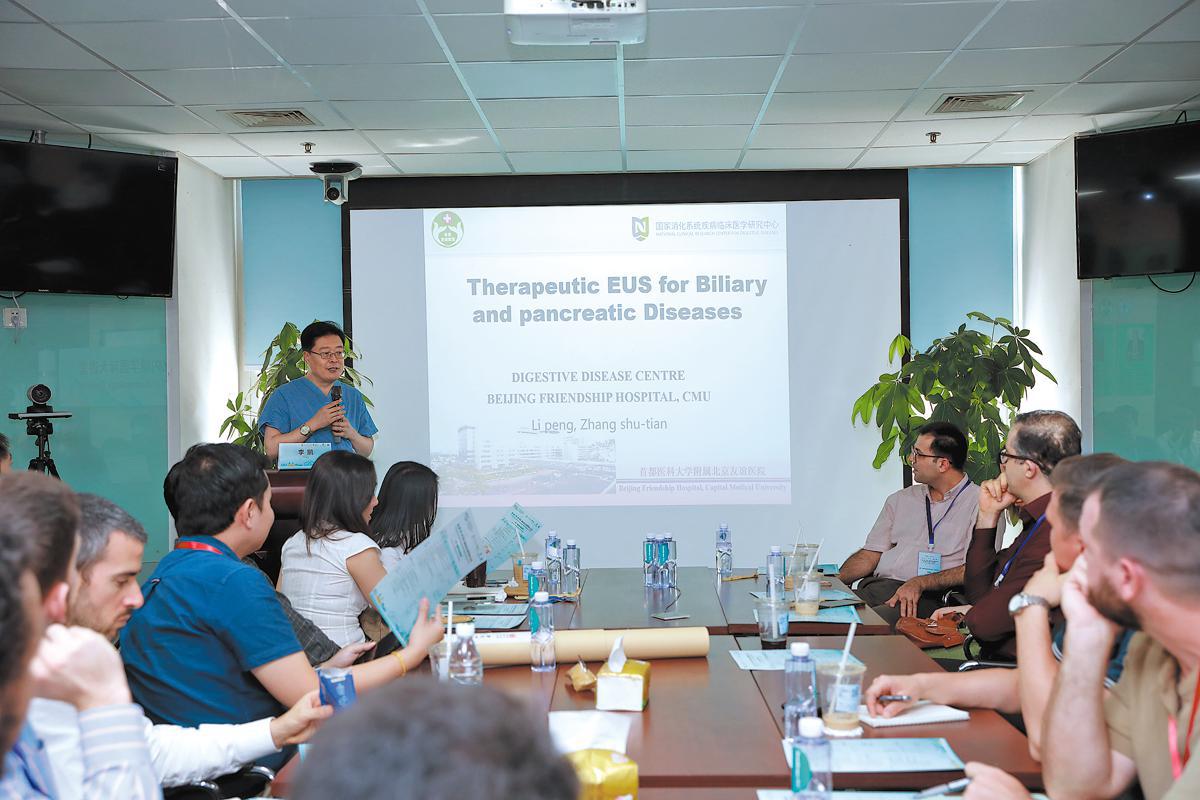Medical progress rises to meet global standards


The endoscopic skills and the quality of domestically produced gastrointestinal endoscopes of Chinese physicians and medical device manufacturers have seen marked advancements in recent years, putting China in a strong position to support other countries in need.
Endoscopy is a minimally invasive procedure that uses a flexible tube equipped with a camera to examine internal organs. Gastrointestinal endoscopy focuses on the digestive tract, enabling physicians to screen, diagnose and treat conditions including ulcers, polyps and early-stage cancers.
Zhang Shutian, president of the Beijing Friendship Hospital affiliated to Capital Medical University and a senior gastroenterologist, said that endoscopy technology was first introduced to China during the initial stages of the country's reform and opening-up that started in 1978.
"Our learning process accelerated significantly in the 1990s through video and livestreaming platforms. This enabled the gradual expansion of endoscopic capabilities from municipal hospitals down to county-level clinics," he said during a recent interview.
"Since the 21st century, we have witnessed remarkable improvements in endoscopic proficiency nationwide," Zhang added. "Today, several Chinese endoscopy centers have achieved world-class standards."
Chinese physicians have developed particular expertise in endoscopic submucosal dissection, also known as ESD. It is an advanced technique for removing early-stage malignant tumors from the gastrointestinal tract, such as those in the esophagus, stomach and colorectum.
"Performing ESD is akin to picking up a single grain of rice with chopsticks," he said. "Because we Chinese grow up using chopsticks, we have naturally gained fine motor skills in our fingers and are exceptionally dexterous for procedures requiring extreme precision, such as dissecting millimeter-sized early cancer lesions."
This growing clinical expertise parallels significant advancements in homegrown endoscopic equipment.
Li Peng, vice-president of the hospital, said that around 2017, domestically made endoscopes accounted for less than 3 percent of China's market share, with even smaller global penetration.
At that time, more than 90 percent of Chinese doctors preferred using imported brands, Li added, citing data from a study that assessed the market share and quality of endoscopes.
"At present, it is estimated that Chinese-made endoscopes now capture 20 to 30 percent of the domestic market and they have gained strong recognition in international markets in Russia, South America and Western Asia," he added.
One notable technological advancement is the clear, high-definition imaging capabilities of domestic products, which help enhance surgical precision, said Li.
Competitive pricing and prompt response to feedback from clinical use have also driven their adoption, he added.
Li has worked directly with manufacturers to optimize endoscopic accessories, particularly focusing on improving hemostasis control and preventing visual field loss after prolonged use of a device.
"The agility of domestic producers is remarkable," he said. "When I request custom modifications, it can take as short as one week for some domestic producers to respond and deliver the modified model to me. But it usually takes much longer for foreign manufacturers to make a reply," he said.
Zhang, the hospital president, said that while domestic products achieve advancements in critical performance metrics, such as their tactile responsiveness and image resolution, their pricing remains competitive.
"I believe in countries involved in the Belt and Road Initiative, domestic products have great potential and can benefit more local patients there," he said.
Chen Lianxin, head of domestic marketing at medical equipment manufacturer SonoScape, headquartered in Shenzhen, Guangdong province, said that the pace of technological advancement in the past decade has been striking.
"The company's products were based on standard-definition imaging about 13 years ago when it made its first entry into the endoscopy field, and then we achieved high-definition imaging and now artificial intelligence has been deployed to further boost clarity," he said.
Chen added that the installation of AI-powered quality control software will help physicians detect suspicious malignant lesions more quickly and accurately.
Li, the vice-president, added that while domestic producers now offer comprehensive solutions for standard gastroscopy and colonoscopy procedures, critical gaps remain in specialized areas.
"Our domestic product lines currently lack duodenoscopes and deep small bowel enteroscopes," he said, adding that it is important to expand domestic capabilities in these specialized domains to achieve a complete product portfolio.
- Youth trace roots by sharing stories
- Food delivery platforms to do away with financial penalties, sparking debate
- Data show rising labor, business disputes
- Bocholt group visits Wuxi to honor friendship
- Domestic tourism sees major jump in visitors and spending
- Vibrant autumn colors attract tourists to Changchun park





































